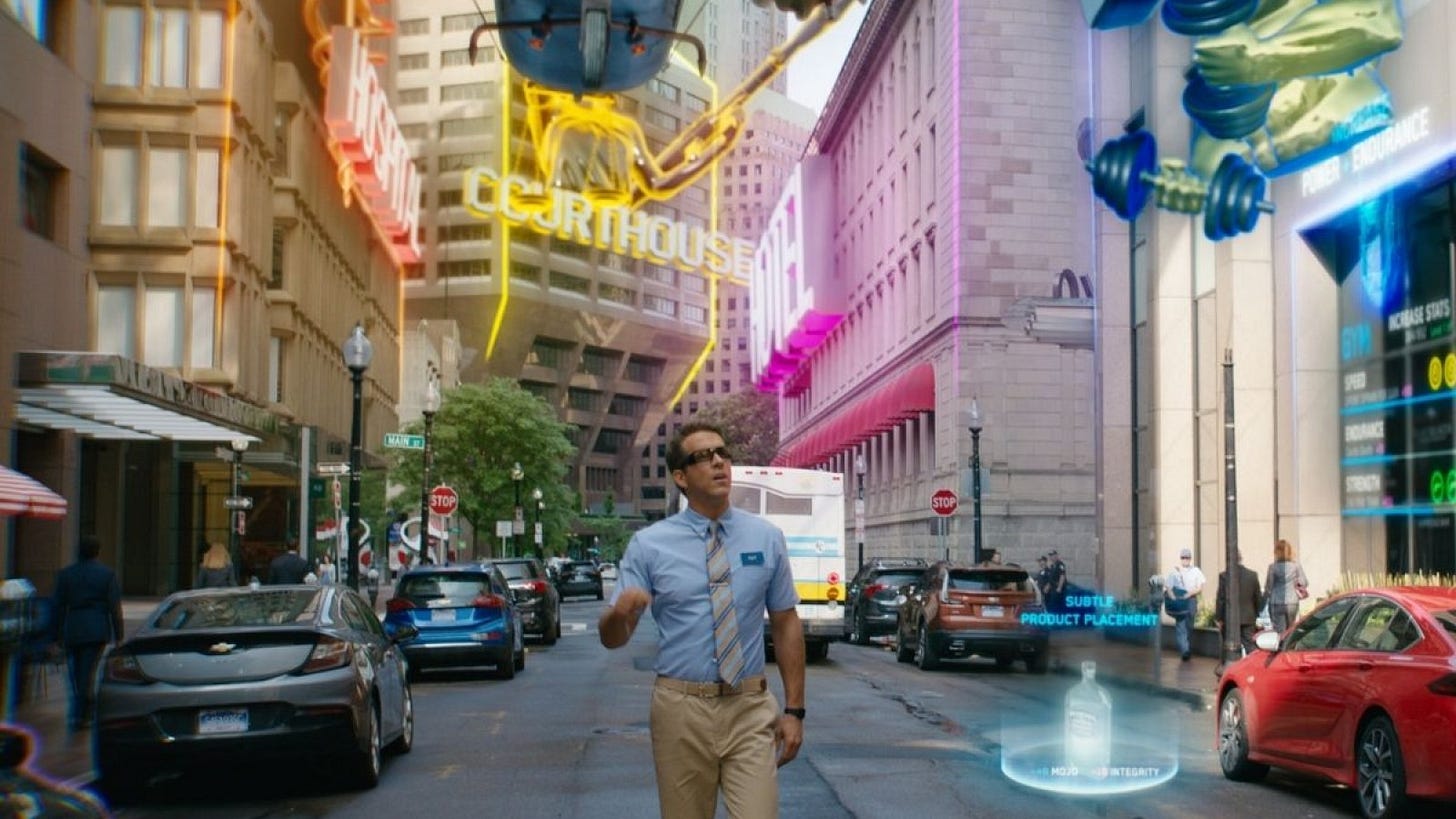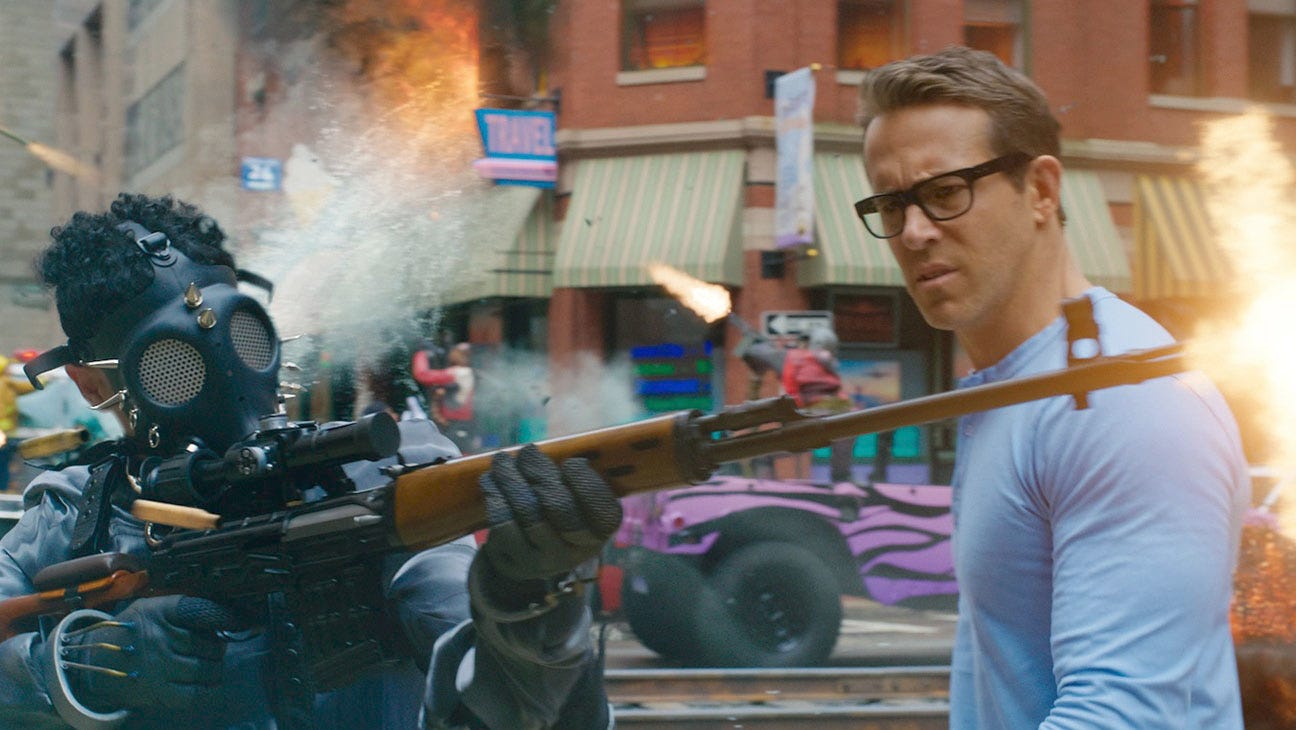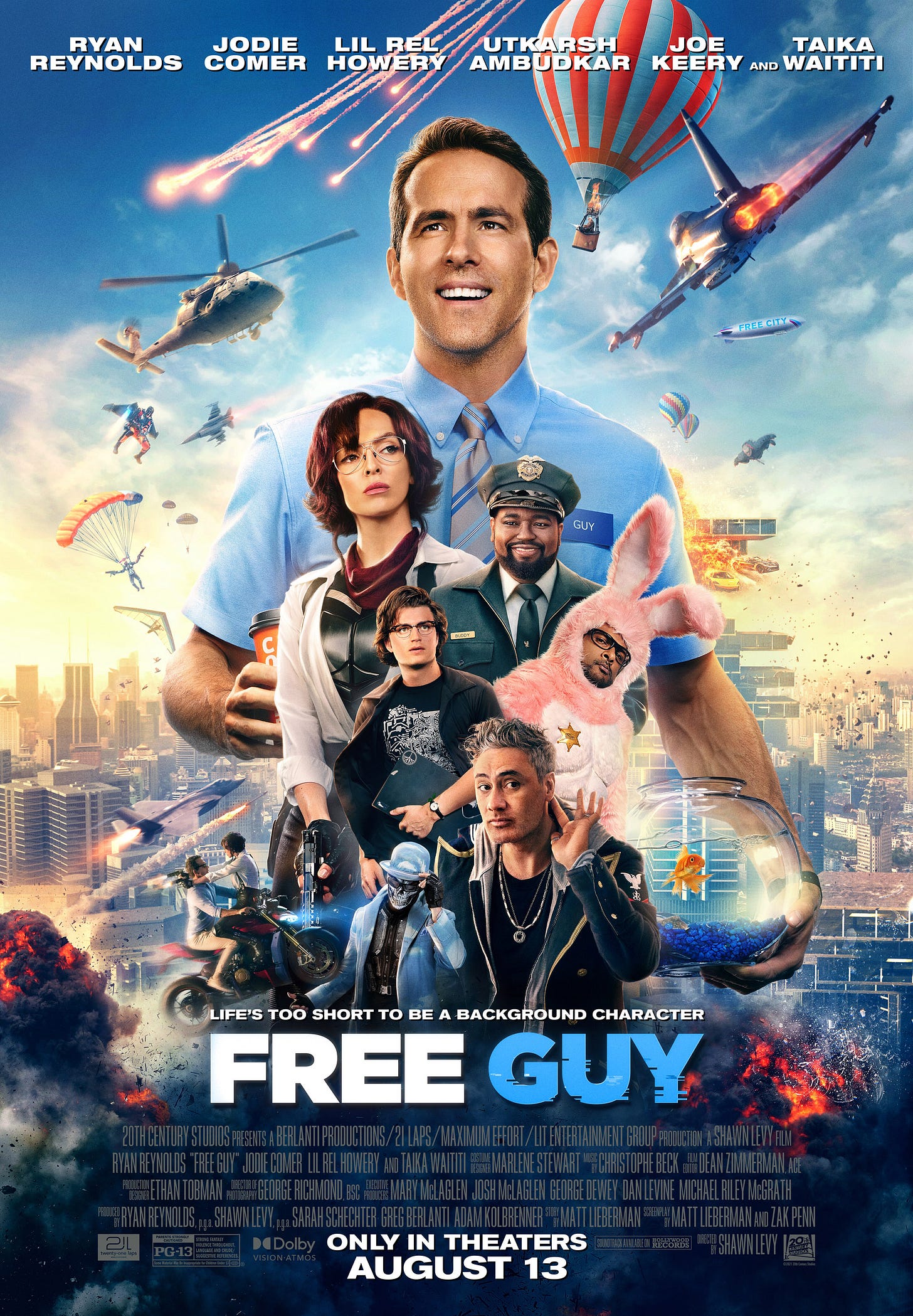Cyber Treatment #1: 'Free Guy' and the Absolute State of Game Design
Disclaimer: May or may not be absolute.
Welcome to the Cyber Treatment, a new series here on The Treatment where I, Charlotte Cleopatra Simmons, swap out my film critic hat for my game designer hat while still using film as a lens for discussing the nuances of video games and gameplay, using the same objectivity-centric approach most have come to know me for.
Today, I’m going to talk about Free Guy while offering up a light crash course in some game design fundamentals, which a lot of real-life modern games would do well to prioritize over… certain other things, we’ll say.
Free Guy is a strange little movie. On the one hand, the way it uses a Grand Theft Auto-inspired backdrop for a story about breaking out of a dystopian loop is equal parts novel and inspiring. On the other hand, it got commercialized within an inch of its life, as is often the fate of films that find themselves at the mercy of studio yes-men like Shawn Levy. As a critic and as a movie-watcher in general, I have a soft spot for this film, albeit one that it only succeeds in poking half the time.
But I wasn’t watching Free Guy as a critic, nor as a movie-watcher. I was watching it as a game designer,1 which is the exact and entire reason I call it a strange little movie. Its indictment of the power fantasy aspect of games like Grand Theft Auto is hilariously unsubtle, and yet, it demonstrates a gross, bafflingly hypocritical adherence to the philosophy of video games as pleasure factories.
But what does this mean exactly? Aren’t video games supposed to be fun?
Well, “fun” is not a useful word to game designers. Anything can be conceivably fun. If game designers were in the market of fun, they could sell blowjobs and still conceivably be achieving their goals.
But game designers are — surprise, surprise — in the market of games, and the core building block of games is gameplay.
So, how do we know that the gameplay is good? By how fun it is? No, because we run into the same problem — anything can be “fun,” so we need to craft and observe gameplay with something a little more falsifiable than that.
This was where my game design instructor, Cory Rodis, taught me about tension. And no, tension is not simply “a thing that feels tense.”
Basically, tension is what happens when a game presents you with two or more choices to make during gameplay, none of which are necessarily preferable to the others, but must nevertheless be made in order to engage with/advance in the game.
Pretty much any first-person shooter, for instance, is built upon a classic offense-defense tension. You have to shoot your opponents to win the game, but by putting yourself in a position to shoot them, you make yourself vulnerable to being shot, which you obviously don’t want, as that means you lose the game.
And so the tension of first-person shooters is expressed in the balance between self-preservation and dealing damage. A good player knows how to read the game and understand which strategy, in the context of this balance, works best at any given time.
Do you camp out and wait for your enemy to reveal themselves, risking them finding a wholly advantageous position over you?
Do you run in guns-blazing so as to take them by surprise at the risk of them marking you first?
Do you bait them out with a few shots and then stop, giving the illusion that you’re reloading so that they’ll try and fight back, only for you to pop them in the head when they go to attack? This, at the risk of running out of ammo faster and leaving you totally defenseless?
And that’s just the basic tension. You can add more nuance to this tension in the form of grenades, gun type, map geometry, the patterns of your opponent’s behaviour, and so on. All of these things affect how you address the offense/defense question.
That’s not all that makes first-person shooters such robust templates for games, either; it’s generally very easy to telegraph gains and losses with these shooters — you shoot enemy, enemy dies, you get points.
That’s what we call feedback — information that the game provides in reference to the choices you make/things that happen in the game, which you often take into account as you continue making choices.
A first-person shooter’s head’s-up display — specifically its more dynamic components like ammo count, noise indicators, hit markers, and your remaining health after being shot — is an example of feedback.
Known gains and losses play an important role in informing the tension and your subsequent strategy. If you have a comfortable lead on your opponent, for instance, maybe it’s wise to amp up your offense so as to run away with the points.
Unless, of course, your opponent is using a sniper rifle, in which case it’s probably better to sit tight and force them to come to you, lest time runs out and your point lead declares you the winner.
You might be able to see how I’m going to tie this back into Free Guy.
Millie (Jodie Comer) and Keys (Joe Keery), two of the film’s heroes alongside Ryan Reynolds’ eponymous Guy, are in open rebellion against the culture of violence in video games. They turn their noses down at killing NPCs, and are instead champions of watching NPCs grow, which is why they made Life Itself, a life simulator whose AI-driven game engine is stolen for the “stupid shooter game” of Free City.
Now, Free Guy opens with Channing Tatum as a player in Free City, gliding into an explosion-ridden metropolis before landing in a cool car next to a supermodel NPC, who rhymes off a “You’re so hot”-type voiceline before Tatum speeds away. As I alluded to earlier, this opening scene asserts Free Guy’s intent to mock/parody the power fantasy aspect of these violent shooter video games.
And yet, as a game designer, I find this to be an incredibly discouraging indicator of the public perception of video games. You see, the simple act of focusing on the power fantasy is a symptom of our inability to understand what video games actually are, and subsequently why the shooter genre actually works so well.
That is, Free Guy is right to mock the power fantasy, yes, but the point of shooter video games isn’t the violence and the resulting power fantasy — it’s the tried-and-true, infinitely robust gameplay framework of offense-defense that they provide.
Fixating on the power fantasy, then, incorrectly and dangerously implies that games are there to validate you and your fantasies, and sure enough…
INTERVIEWER: To get a little personal, what’s the thing that gets you up in the morning?
MILLIE: Medium coffee, cream, two sugars, and… What’s the other thing? Oh, yeah. An insatiable thirst for validation.
That’s right — the people we’re meant to cheer for in Free Guy, hellbent on making a game like Life Itself that you can watch instead of play2, have also missed the point of games.
Here’s the thing; your brain is activated in a very specific way when you’re interacting with good gameplay systems. You’re actively strategizing with respect to your win condition, and when your strategy works, you meet the win condition and you feel good. It’s true that winning anything feels good, but it’s the specific, iterative effort that those strategies demand of us that not only makes the payoff that much better, but also exercises our brains far beyond the baseline of escapism.
Games that intend hundreds or thousands of hours of pure escapism assume that we want to escape our lives for that long.
At that point, maybe we should be doing something about our lives.
This is not the same as, say, “cozy” titles where you feed your digital cat when they’re hungry or grow food on your digital farm. These are not games. They’re a perfectly valid form of media, but, fundamentally speaking, they are not games.
Let me explain. Say you’re playing a pet simulator where you take care of a cat, and a “hungry” status indicator appears above the cat’s head when it needs to be fed, and so you need to give him food to make sure he’s not hungry anymore.
Feeding the cat is a decision, but there’s no tension; why wouldn’t you feed the cat? In any given shooter, there are any number of reasons why you wouldn’t go on the offense even if that’s what you ultimately need to do to win the game, but in any given pet sim, there’s no gameplay inherent to feeding the cat — you just do it, and there’s no reason not to.
Now, you could gameify a premise like this. Say the cat has a digestive disease, and your goal as a player is to stock up on special foods that help him fight the disease, with every meal-time serving as a level that you have to complete. The levels are divided into RTS puzzles using the cat’s stomach as the map, and you need to keep the cat’s stomach full with food while making sure that that food doesn’t get infected by invading disease cells. The food itself would have defenses against these cells, and different foods could provide different possible arrangements in the stomach, protections against diseases and weaknesses against others, and other such nuances.
Of course, now it’s not really a pet sim so much as a strategy game, and the gameplay might be overwhelming and anxiety-inducing to the person who just wants to chill and feed the cat. This person is entitled to the latter, but it remains that the thing they want and enjoy is not a game — it’s pacification and validation.
I’m not saying these things absolutely can’t exist, but when you predicate the bones and expectations of a medium on pacification and validation, you create a culture around that medium that’s at odds with the flourishing of the medium itself. We’re seeing this in film in the form of Netflix-original second-screeners.
But this is not the norm with film culture. Film culture does not reward these movies, and instead admires adherents and innovators of the craft like Christopher Nolan, Chloé Zhao, Sean Baker, and Jane Campion.
Game culture has not been so lucky. Baldur’s Gate 3, for instance, is out here receiving GOAT status despite its very apparent validation-first design philosophy. I’ll save that for when I write about Dungeons & Dragons: Honor Among Thieves, though.
Instead, let’s keep the focus on shooters, one of which — Overwatch — is an old flame of mine, and has fallen hard from modern gaming’s advent of validation.
I’m going to assume that I don’t need to introduce you to Overwatch — it’s a hero shooter, which iterates upon the trusty offense-defense tension of first-person shooters by involving character-specific stats, strengths, weaknesses, weapons, and abilities that deepen the strategy and decision-making inherent to gameplay.
And now I’m going to try and illustrate how it got neutered/continues to be targeted by the spectre of validation in as few words as I can muster:
Overwatch 2 (which replaced the original Overwatch) introduced a Battle Pass system that offers cosmetic rewards based on how much time you put into the game. This, to reward players for playing the game and giving them a goal to work towards, even though the goal in a competitive game is *checks notes* to win it, and perhaps get better at it.
There are also purchasable “Tier Skips,” which allow you to progress in the Battle Pass without playing the game. You can get the rewards without playing the game, as though playing the game is a chore that you can pay a premium to avoid. What’s even the point of the game anymore?
The game’s competitive mode prioritized “fair matchmaking” by not pairing up six/five3 random players against six/five friends who queue together, as if teaming up in a team-based hero shooter is somehow an unfair strategy that must be punished.
Players constantly complain about “unfun” and “low-skill” abilities like stuns and immortality fields “ruining” their mechanically-deft plays and making them feel shitty. My brother in Christ, if you’re playing a competitive shooter to feel good about yourself, you’re delusional. These games are inherently frustrating — you can make the right choice, only to not follow up mechanically, or you might get rocked by a threat you had no chance of clocking; of course that’s not fun. Dying isn’t fun, but frustration and loss is a part of every competitive game, especially when the gooeyness of aim and athleticism is involved.
You think soccer players rally against the rules of their game after dangling the defense, only to get smothered by the goalkeeper’s outstretched hands? No; they craft plays around dealing with it. A better soccer player would have made the pass to their open teammate instead of trying to flashily blaze through the goalkeeper.
You cannot predicate the quality of a game on how well it caters to mechanical skill expression, because then it’s more concerned with player dopamine than the function of the gameplay. In making a game, it must begin and end with the chess — the choices.
Because when you get right down to it, any mechanical execution is a matter of luck. You can practice your mechanical skills so as to succeed more consistently, certainly, but all reflex/athleticism-sensitive mechanics in any game — from putting enough weight on the pass to lining up a headshot — are ultimately weighted dice rolls. And they have to be; if they weren’t, it would completely kneecap the tension of the gameplay. If you could choose whether or not to hit a shot in a first-person shooter, why would you ever not hit one?
And you cannot — cannot — build a real game with chance as your base. This is in no way suggesting that mechanical skill expression is harmful to games; it just can’t be foundationally prioritized over the choices/strategies that precede said expression.
I speak urgently when I say that Blizzard needs to stop incorporating this kind of player feedback into the design process. Most players are not concerned with how good a game is — they’re only concerned with how good the game makes them feel, and the moment you take your eye off the gameplay ball to focus on pleasure, it becomes very easy for your game to fall apart at the seams.
Because here’s the regular, degular truth of the matter, folks; games are fussy. You need to be uncomfortably meticulous to design it over the finish line, and, like any piece of art, they’re never actually finished — you just get to a point where you decide to stop building it.
But unlike other kinds of art, a “good game“ isn’t actually as subjective as we would usually consider such a phrase. You see, in the context of a game, the benchmark for quality can be determined by how closely the game’s mechanics work as intended by the game designers, on both an individual and collective level.7
Identifying this is a matter of asking or saying something falsifiable, i.e. “By making the weapon upgrades dependent on the same resource as armour upgrades, players are faced with the tension of fast-tracking an offensive build, fast-tracking a defensive build, or opting for a balanced build that will take longer to create because of the time needed to get all of those resources for the upgrades.”
That might be an objectively true statement, but you need to consider it in the context of your game. If there’s no time limit element, for instance, there’s probably no reason for you to not go for the balanced build, and so the tension of using the same resource for both weapon upgrades and armour upgrades — insofar as we understand the intent of the mechanic, per that falsifiable statement — becomes moot; dead weight that unnecessarily encumbers the game.
This is why you need to pay close attention when building your gameplay system; even something that’s objectively true can be unwittingly compromised — and even subsequently compromise your entire game — if you’re not careful. In designing games, you need to have a clear idea of what choices/tensions you’re going for, and how they’re all going to fit together into an overarching gameplay system.
Except, that doesn’t matter if your game isn’t predicated upon the health of gameplay systems, and instead focuses on comfort zones and validation. If you’re something like the fictional Life Itself, then you’re not even predicated on the presence of a gameplay system at all.
Right away, that should disqualify you from the game medium. And yet, so many other pieces of media like Life Itself — that build themselves on non-game values — are occupying the market space that should be for games. And they’re praised for doing so.
This is why I started the Cyber Treatment; not to yuck the Life Itselfs and cat sims of the world, but to highlight what’s being lost when we allow validation to be the expectant skeleton of game design. It’s bad for the cultural and long-term psychological health of the players, and it’s bad for the games themselves; it is nothing short of disgustingly insulting to see games be measured by their capacity for dopamine rather than how accessibly they present and then maintain consistent, tension-centric depth and strategy.
I believe with my whole entire chest that video games are capable of being great art when they actually show respect to their gameness, the way that film is great art whenever it’s not surrendering to whatever the Minions are doing these days. My question is, can modern game designers — and modern audiences — believe that, too?
I’ve seen this film twice. Once in late 2021, and once last week at the time of posting.
?????????????
The original Overwatch used a 6v6 format, converting to 5v5 with the launch of Overwatch 2.
Later one Tank with the switch to 5v5.
Also affecting this decision was the then-dominance of the GOATS team composition (a 3 Tank, 3 Support comp with Zarya, Reinhardt, Brigitte, Lúcio, and usually a Moira and D.Va to round it out) at the highest levels of play. Those players, of course, make up a very small percentage of the playerbase, and I’m not convinced that a 2-2-2 lock was needed to solve the GOATS issue.
And this represents just a fraction of the problem with Overwatch’s competitive framework, which I could write a whole other piece on. I might.
You could argue that this is how we measure the quality of a film, too, but films traffic in the impenetrably subjective arenas of emotion and philosophy, even if the techniques used to convey these things allow us a bit of objectivity in their discussion. Games, however, traffic top-to-bottom in tangible and observable gameplay systems, and so we can fully dissect the quality of a game by measuring the designer’s intent against how the mechanics actualize. If people enjoy it, that’s a bonus.











This is a hell of a swing, and one I deeply respect.
This nails something most critics fumble: games aren’t just digital stories or dopamine slot machines. They’re tension systems. Interactive ethics labs. Strategic engines. And Free Guy, despite its gestures toward liberation, reinforces the very dopamine-chasing logic it pretends to critique.